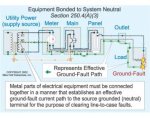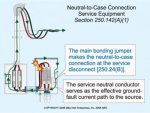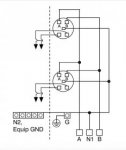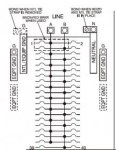cubgirl
Member
- Location
- madison, AL
Hi everybody...
I replaced two 2-2-2-4 SER with 2/0-2/0-2/0-4 & 1/0-1/0-1/0-4 to get 125A in each unit for a two-family. The upstairs SER was de-rated for attic heat & length. I have a 2 gang Siemens WP2211RJ gang meter and a 200A panel (P4040B1200CU) back fed with a 125A breaker and a 125A lug panel (P2020L1125CU).
I paid an installer to do this work. He cut the #4 ground off both SER's at the meter end, over my objections, saying they were redundant. He connected the SER neutrals to the grounded neutral from the POCO. The units were energized & everything appears OK. But I'm worried about those cut grounds.
The units are empty and I don't want to get tenants in them until I determine if this setup is safe. In the last two days, I've read a lot about earth ground, equipment ground, bonding, etc.
At first, I thought the following after reading the NEC and looking at the (1st picture) of EGC bonded to neutral:
250.130 Equipment Ground connections at service equipment shall be made as indicated in 250.130(A) or (B).
since my gang meter is grounded to earth, the EQPT GND on the SER needed to be connected to the grounded service neutral conductor and the bond between the neutral & ground should be removed at each panel.
if the gang meter were not grounded, then the EQPT GND on the SER still should have been attached to earth ground but the bond between the neutral & ground at each panel would remain intact and each individual panel should be connected to an earth ground.
BUT THEN, I saw the 2nd picture on Mike Holt's site of neutral to case connection and read the following:
"At service equipment, the service neutral conductor provides the effective ground-fault current path to the power supply [250.24(C)]; therefore, an equipment grounding conductor isn't required to be installed within PVC conduit containing service entrance conductors [250.142(A)(1) and 352.60 Ex 2]."
So, if the gang meter is service equipment and the installer connected the SER neutral to the grounded neutral from the POCO, is what he did OK?? It looks exactly like the 2nd picture. (My understanding is the service equipment comes bonded from the manufacturer.)
Can somebody shed some light on this for me please? I need to either move on or get this fixed ASAP.
thank you
cubgirl
I replaced two 2-2-2-4 SER with 2/0-2/0-2/0-4 & 1/0-1/0-1/0-4 to get 125A in each unit for a two-family. The upstairs SER was de-rated for attic heat & length. I have a 2 gang Siemens WP2211RJ gang meter and a 200A panel (P4040B1200CU) back fed with a 125A breaker and a 125A lug panel (P2020L1125CU).
I paid an installer to do this work. He cut the #4 ground off both SER's at the meter end, over my objections, saying they were redundant. He connected the SER neutrals to the grounded neutral from the POCO. The units were energized & everything appears OK. But I'm worried about those cut grounds.
The units are empty and I don't want to get tenants in them until I determine if this setup is safe. In the last two days, I've read a lot about earth ground, equipment ground, bonding, etc.
At first, I thought the following after reading the NEC and looking at the (1st picture) of EGC bonded to neutral:
250.130 Equipment Ground connections at service equipment shall be made as indicated in 250.130(A) or (B).
(A) For Grounded Systems. The connection shall be made by bonding the equipment grounding conductor (i.e., the unsheathed SER ground cable) to the grounded service conductor (i.e., the grounded neutral from utility company) and the grounding electrode conductor (i.e., the earth ground).
since my gang meter is grounded to earth, the EQPT GND on the SER needed to be connected to the grounded service neutral conductor and the bond between the neutral & ground should be removed at each panel.
if the gang meter were not grounded, then the EQPT GND on the SER still should have been attached to earth ground but the bond between the neutral & ground at each panel would remain intact and each individual panel should be connected to an earth ground.
BUT THEN, I saw the 2nd picture on Mike Holt's site of neutral to case connection and read the following:
"At service equipment, the service neutral conductor provides the effective ground-fault current path to the power supply [250.24(C)]; therefore, an equipment grounding conductor isn't required to be installed within PVC conduit containing service entrance conductors [250.142(A)(1) and 352.60 Ex 2]."
So, if the gang meter is service equipment and the installer connected the SER neutral to the grounded neutral from the POCO, is what he did OK?? It looks exactly like the 2nd picture. (My understanding is the service equipment comes bonded from the manufacturer.)
Can somebody shed some light on this for me please? I need to either move on or get this fixed ASAP.
thank you
cubgirl






